The Wonders in the base game are only partially based on the Seven Wonders of antiquity. One of the main differences is that they are made more generic, so that each could represent similar real or imagined constructions besides the one that inspired its inclusion: Great Pyramids could represent the Pyramids of the Sun and the Moon in Teotihuacan just as well as those on the Giza Plateau, Great Statue could be one of the Colossi of Memnon rather than the Colossus of Rhodes, Great Mausoleum could be Taj Mahal rather than the Mausoleum of Halicarnassus.
The other main difference is in the selection. The number of Wonders
is kept at seven, even though the existence of variants of the ancient
list means that eight different constructions merits inclusion in the
category Seven Wonders
. Yet two that are not found on any ancient
version of the list are included: Great Library based on the
Library of Alexandia, and Great Wall based on the Great Wall of
China – which unlike all the others is not located in the Mediterranean
Basin.

This expansion adds more Wonders in the same vein. Completing all versions of the ancient Greek list of Seven Wonders are Great Temple (based on the Temple of Artemis at Ephesos), Great Idol (based on the Statue of Zeus at Olympia) and Great Gate (based on the Ishtar Gate in the Walls of Babylon). The Roman Empire produced many constructions that were slightly too late to be included in the classical lists, but have inspired three cards: Great Arena (based on the Colosseum), Great Bridge (based on Trajan’s Bridge over the Danube) and Great Baths (based on the Imperial Baths – the illustration is of the Baths of Caracalla, which were the grandest until superseded by the Baths of Diocletian). Taking leave of the Mediterranean Basin, Great Megaliths – a somewhat redundant term (based on Stonehenge) and Great Tower (based on the Porcelain Tower of Nanjing) round off the list. With its early 15th century date, the latter is quite a bit later than the other Wonders, but others similar to it were made much earlier.
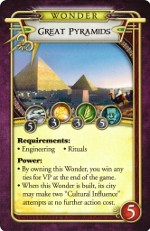
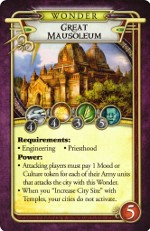
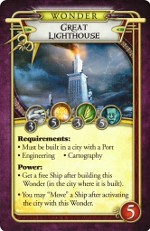
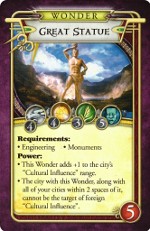
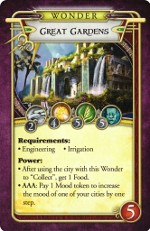
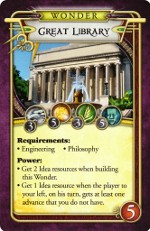
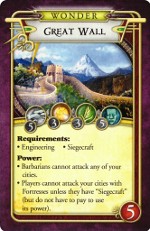
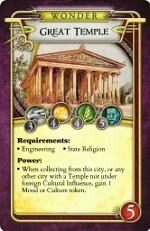
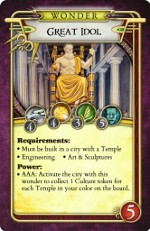
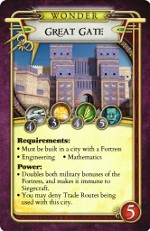
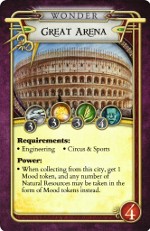
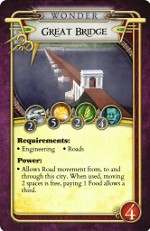
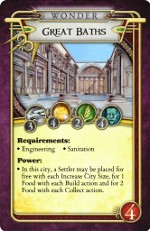
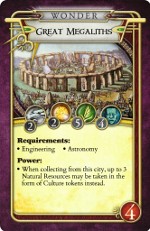
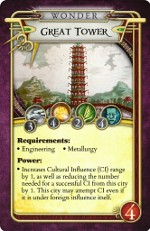
Like the originals, all Wonders require Engineering and one other advance unique to this Wonder. Like the Great Lighthouse, two also require a specific city-piece. There is a little twist to this, though. The Great Lighthouse must be built in a city with a Port, but unless that city is captured from another player with the Port already built, there is a “hidden” advance requirement in that building a Port requires the Fishing advance. Now, this does not make any difference, since the explicit advance requirement for this Wonder is Cartography, which also requires Fishing. For the new Wonders with city-piece requirements, there is no such overlap, so they do actually have “hidden” requirements. However, this is balanced by their explicit requirements being advances that do not depend on other advances (they are the only ones that have the top advance of a category as requirement).
In order to encourage earlier building of Wonders, the building cost of five of the Wonders is reduced from 11 Natural Resources (2–5 of each type) and 5 Culture tokens to 9 Natural Resources and 4 Culture tokens. Correspondingly, the Victory Point value of these Wonders is reduced from 5 to 4. The background color of the “Wonder” heading on these cards is changed from gold to silver to make it easier to notice this from across the table.
Palaces

Palaces are a special type of city-piece which are free-standing and independent of player color, just like the Wonder pieces. They form a shared pool of two Palaces per player, but any player may build as many of these as otherwise eligible to.
A Palace is added using an “Increase City Size” action, and requires any Government advance. The cost is 1 each of Food, Wood, Ore, and Gold.
A Palace may only be built in a city that is larger than each of the player’s other cities. With Clash of Cultures: Civilizations this requirement is instead that a Leader must be present in a city.
As they are free-standing, Palaces do not occupy one of the four “slots” around the core Settlement, and thus makes it possible to build a size 6 city. References to a “size 5 city” must therefore be interpreted as a “city with a size of at least 5”.
When activating a city with a Palace for the second time in a turn, its owner may pay 1 Gold to avoid reducing the Mood of the city.
Being uncolored, Palace tokens are immune to Cultural Influence, but unlike the Obelisk city-pieces from Civilizations they score points for the player controlling their cities at the end of the game.
Palaces may be placed on Event cards where they score points for their owners at the end of the game together with at least one colored city-piece (which will keep track of their owners). In this case they count as two city-pieces.
Exploration Cards
An Exploration Card is drawn when turning a region tile without Barbarians (with Civilizations also without Pirates) as a result of normal exploration (by land or sea). This means that something happens or appears at (almost) every turned tile. To gently encourage exploration rather than turtling, more effects are good than bad. However, further movement is often required in order to utilize these opportunities, so they might instead go to a neighbor that is quicker to react to them.
Several cards requires non-player units or city-pieces to be placed on the board. These are taken from the supply of the active player, but are not considered as belonging to any player for any other purpose than counting towards the piece limit, and does thus not yield Victory Points at the end of the game. Their non-standard placement makes the distinction betwen these and those owned by the player clear. If you capture or otherwise claim such a piece in another player’s color, immediately replace it by the same type in of your own color (if you don’t have any piece of this type left, remove it and gain 1 Gold instead).
When a random city-piece is called for, the type is determined by a die roll according to the following table:
In order to incorporate aspects of Civilizations when present without requiring this, two of the new city-pieces are included; these results are simply rerolled if playing without this expansion. A result requiring a type which the active player does not have any piece left of is likewise rerolled. “Port” results will also have to be rerolled if no eligible space is adjacent to water.
Many cards requires a space with certain properties to be chosen and/or certain pieces to be placed. If such a space does not exist on the tile, or any non-random piece required is unavaliable, the entire card is ignored.
The detailed order of choices and revealed information is as follows:
- Reveal the region tile.
- Turn over an Exploration card if the tile itself doesn’t trigger Barbarians or Pirates.
- Determine the orientation of the tile, place it and move the exploring group onto it if possible.
- Discard the card if it requires choosing a space of a type not present or placing a non-available piece.
- Roll a die to determine city-piece type if applicable.
- Follow the remaining instructions in the first paragraph.
- If there is a second paragraph, leave the card beside the board until this text is no longer applicable.
Some cards result in the placement of Barbarian pieces in configurations not explicitly covered by the base game rules. These situations are handled with as little modification to the rules as possible. Any city or Army with at least one Barbarian unit is considered Barbarian in all respects, and Army units may be added to them when resolving Event cards with the “Add Barbarians” icon. Razing a Barbarian city upon capturing it yields 1 Gold per city-piece.
Any combination of markers including at least one unit or city-piece blocks collection from that space.
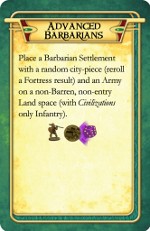
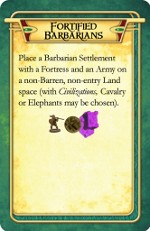
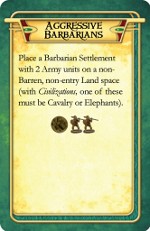
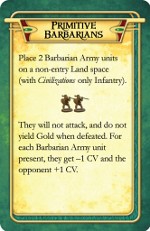

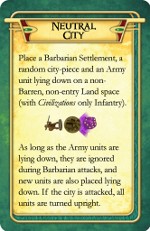
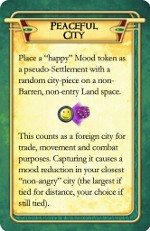
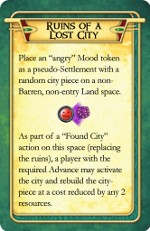
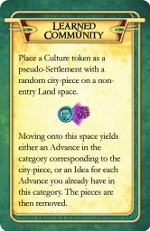
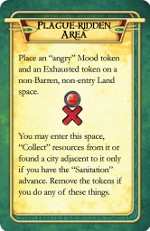
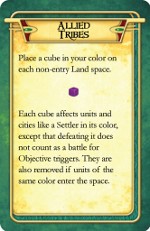
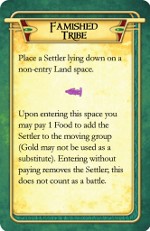
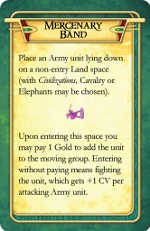
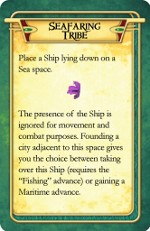

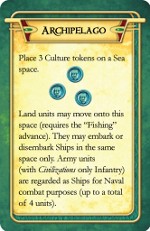
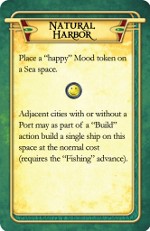
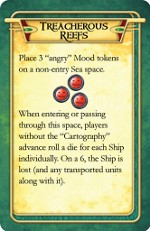
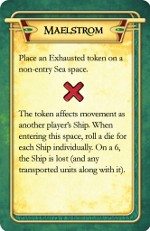


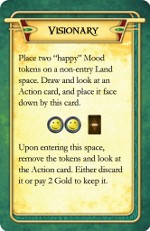

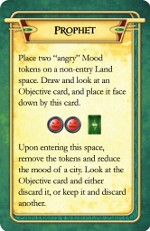

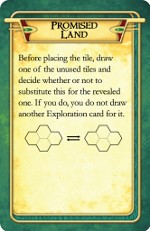
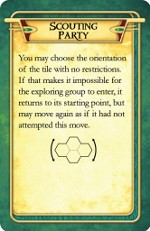
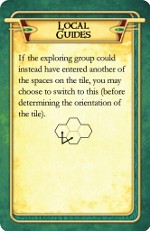
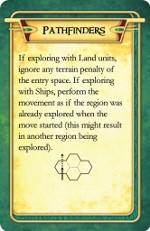

High resolution files for printing (600 ppi)
| Description and link | Orientation | Number of sheets |
Number of cards |
|---|---|---|---|
| New Wonder cards | Landscape | 1 | 8 |
| Original Wonder cards | Landscape | 1 | 7 |
| Cardbacks for Wonder cards | Landscape | 2 | – |
| Wonder and Palace Tokens | Portrait | 1 | (8) |
| Exploration cards, page 1/3 | Portrait | 1 | 9 |
| Exploration cards, page 2/3 | Portrait | 1 | 9 |
| Exploration cards, page 3/3 | Portrait | 1 | 9 |
| Exploration cards, cardbacks | Portrait | 3 | – |
| Summary cards | Landscape | 1 | 4 |
| Total | 12 | 46 (54) |
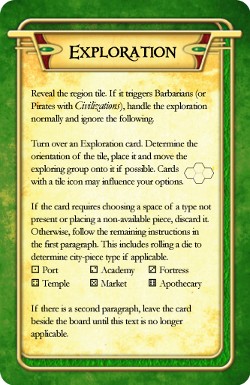
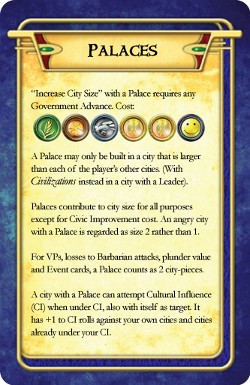


Todo:
☞ Rework “Palaces” summary card with new rules; update print sheet without drop shadow.